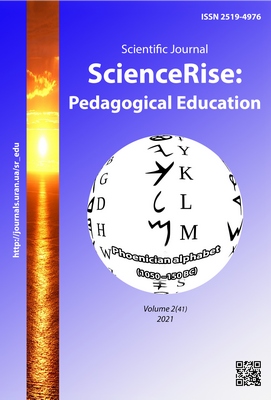Chemical safety as a component of general and professional competences in training of future doctors
DOI:
https://doi.org/10.15587/2519-4984.2021.228123Keywords:
chemical safety, competence, training of future doctors, standards of medical trainingAbstract
The study analyzes the content of international (project "Harmonization of educational structures in Europe") and Ukrainian (industry standard of higher education field of knowledge 22 "Health Protection", specialty 222 "Medicine") legal documents of training future doctors in the context of modern ideas on chemical safety. The components of chemical safety are identified: understanding of the chemical factor as an integral danger to human health; knowledge of methods of labeling chemicals and products; compliance with the rules and safety measures for working with chemical products throughout the life cycle. The content of the main professional competencies of the second level of medical education of the project "Harmonization of educational structures in Europe", which are related to the application of chemical safety issues in the future professional activity of the future doctor: to consult with the patient; provide emergency medical care in emergencies; apply the principles, skills and knowledge of evidence-based medicine; promote health, to address public health issues and work effectively in the health care system, is revealed.
The general and professional competencies of the future doctor in the field of chemical safety, which are stated in the industry standard of higher education in the field of knowledge 22 "Health Protection ", specialty 222 "Medicine", are established: desire to preserve the environment; ability to carry out sanitary and hygienic and preventive measures; ability to conduct epidemiological and medical-statistical studies of public health; ability to assess the impact of the environment on the health of the population (individual, family, population); ability to implement resource efficiency activities
References
- On Higher Education (2014). Ukrainian law No. 1556-VII. 01.07.2014. Available at: http://zakon4.rada.gov.ua/laws/show/1556-18
- Kontseptsiia pidvyshchennia rivnia khimichnoi bezpeky (2008). Rozporiadzhennia Kabinetu Ministriv Ukrainy No. 1571-r. 17.12.2008. Available at: https://zakon.rada.gov.ua/laws/show/1571-2008-%D1%80#Text
- Reibnegger, G., Haas, J., Neges, H., Smolle, J. (2008). Die Reform des Medizinstudiums an der Medizinischen Fakultät/Universität Graz. Zeitschrift Für Hochschulentwicklung, 3 (3), 48–61. doi: http://doi.org/10.3217/zfhe-3-03/05
- Burger, W. (2003). Reform des Medizinstudiums. Positive Erfahrungen an der Charité Berlin. Deutsches Ärzteblatt, 100 (11), 686–689.
- Bollinger, H., Hohl, J. (1981). Auf dem Weg von der Profession zum Beruf. Zur Deprofessionalisierung des ÄrzteStandes. Zeitschrift für sozialwissenschaftliche Forschung und Praxis, 32 (4), 12.
- Swing, S. R. (2007). The ACGME outcome project: retrospective and prospective. Medical Teacher, 29 (7), 648–654. doi: http://doi.org/10.1080/01421590701392903
- Krytskyi, I. O., Hoshchynskyi, P. V., Krytskyi, T. I., Horishnyi, I. M., Mochulska, O. M., Krytska, H. A. (2018). Formation of the professional competence of the future doctor at the example of students of the medical faculty in TSMU. Medical Education, 3, 44–47. doi: http://doi.org/10.11603/me.2414-5998.2018.3.8849
- Filonenko, M. (2015). Psykholohiia osobystisnoho stanovlennia maibutnoho likaria. Kyiv: Tsentr uchbovoi literatury, 334.
- Kulbashna, Y., Gudaryan, O. O., Nikonov, V. V., Idashkina, N. G. (2016). Identification of special competences for Master degree in dentistry: draft. Medical Perspectives, 21 (4), 23–27. doi: http://doi.org/10.26641/2307-0404.2016.4.90029
- The Tuning Project (Medicine). Available at: http://www.unideusto.org/tuningeu/images/stories/Summary_of_outcomes_TN/Learning_Outcomes_Competences_for_Undergraduate_Medical_Education_in_Europe.pdf
- Haluzevyi standart vyshchoi osvity pidhotovky na druhomu (mahisterskomu) rivni Mahistra u haluzi znan 22 – «Okhorona zdorovia» za spetsialnistiu 222 «Medytsyna» (2018). Kyiv-Vinnytsia. Available at: https://www.vnmu.edu.ua/downloads/pdf/standart_VO_med_20190408-140905.pdf
- Ishchenko, A. A. (2017). Kompetentnist z khimichnoi bezpeky yak skladova zberezhennia zdorovia liudyny. Zahalna teoriia zdorovia ta zdoroviazberezhennia. Kharkiv: V-vo Rozhko S. H., 339–346.
- Ishchenko, A. A. (2018). Kompetentnist iz khimichnoi bezpeky yak pedahohichna problema u svitli pidhotovky maibutnikh likariv. Zbirnyk naukovykh prats «Pedahohichni nauky», 2 (LXXXIII), 38–42.
- Ishchenko, A. (2018). The formation of knowledge on toxicants as the components of chemical safety for future doctors during their studies of bioorganic chemistry and biochemistry. ScienceRise: Pedagogical Education, 5 (25), 47–52. doi: http://doi.org/10.15587/2519-4984.2018.139414
Downloads
Published
How to Cite
Issue
Section
License
Copyright (c) 2021 Алла Анатольевна Ищенко

This work is licensed under a Creative Commons Attribution 4.0 International License.
Our journal abides by the Creative Commons CC BY copyright rights and permissions for open access journals.
Authors, who are published in this journal, agree to the following conditions:
1. The authors reserve the right to authorship of the work and pass the first publication right of this work to the journal under the terms of a Creative Commons CC BY, which allows others to freely distribute the published research with the obligatory reference to the authors of the original work and the first publication of the work in this journal.
2. The authors have the right to conclude separate supplement agreements that relate to non-exclusive work distribution in the form in which it has been published by the journal (for example, to upload the work to the online storage of the journal or publish it as part of a monograph), provided that the reference to the first publication of the work in this journal is included.








